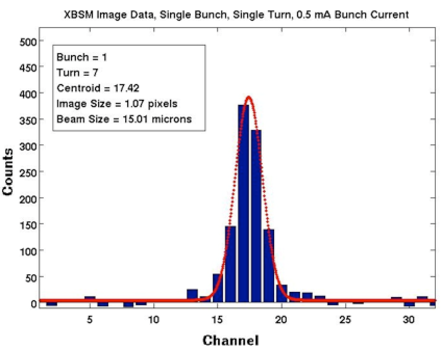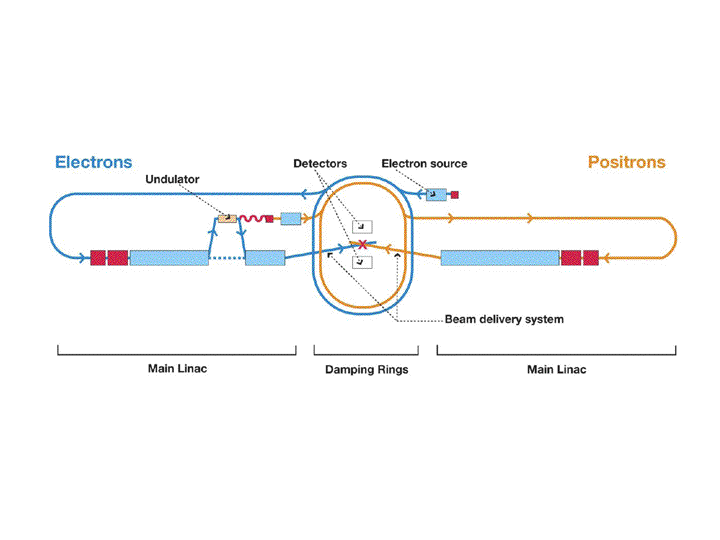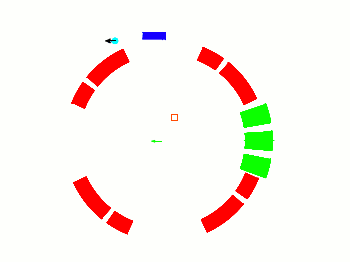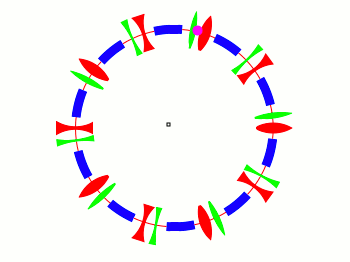Optical Stochastic Cooling
Ultra-low emittance storage rings
The Cornell Electron Storage Ring Test Accelerator ( CesrTA ) is our laboratory for the study of the physics of the very low emittance electron and positron beams in a high energy circular accelerator. CesrTA is the best instrumented storage ring in the world for the study of single particle dynamics and collective effects including- Wakefields and impedance
- Linear and nonlinear optics design
- Linear and nonlinear dynamics
- Electron cloud dynamics
- Electron cloud growth and decay
- Intra-beam scattering
- Fast Ion instability
- Touschek scattering

To achieve the low emittance beams that are essential to the study of collective effects we have developed instrumentation and techniques for obtaining maximum cooling, by identifying and correcting sources of emittance dilution. We have achieved the world record lowest vertical emittance positron beam. The experimental program is enabled by the ongoing development of state of the art instrumentation for measuring beam height, width, length, and position with ever greater precision, to monitor the development of the electron cloud, to characterize the materials used to mitigate the cloud. Our group has developed an extensive library of codes for modeling collective effects, including intra-beam scattering, fast ion and electron cloud effects in electron and positron beams respectively, as well as short range wakefields that manifest as emittance growth and instabilitiey of single bunches, and long range wakes drive induce multi-bunch instabilities. But much work remains to be done to fully understand the complex behaviors typical of circulating particle beams.
Linear Collider Damping Ring R&D
 The accelerator is designed to collide electrons and positrons at center of
mass energy in excess of 0.5TeV. We are investigating some of the
properties of the positron source. The positrons are created when
an intense pulse of polarized photons strikes a thin titanium target. (The circularly polarized
photons are generated by the passage of a
200GeV electron beam through a several hundred
meter long helical undulator. )
The net angular momentum of the photons emerges as polarization of the
positron beam.
As electroweak interactions are left-handed, backgrounds are suppressed in the collisions of polarized beams, enhancing the effective luminosity of the collider.
A train of some 2000 such positron bunches
fills a 3.2 km circumference damping ring.
The initially hot bunches of positrons circulate for just 200ms in the
damping ring, after which they emerge with phase space volume (temperature)
reduced by 6 orders of magnitude. The positron bunches are cooled by radiation damping.
The damping time is minimized with the help of more than 100 meters of high field superconducting wiggler magnets. The cold positrons are
then spin rotated,bunch length compressed and then injected into the front
end of the linac
where they begin their journey of acceleration from 5GeV to 250GeV
through 15 km of superconducting RF cavities.
The accelerator is designed to collide electrons and positrons at center of
mass energy in excess of 0.5TeV. We are investigating some of the
properties of the positron source. The positrons are created when
an intense pulse of polarized photons strikes a thin titanium target. (The circularly polarized
photons are generated by the passage of a
200GeV electron beam through a several hundred
meter long helical undulator. )
The net angular momentum of the photons emerges as polarization of the
positron beam.
As electroweak interactions are left-handed, backgrounds are suppressed in the collisions of polarized beams, enhancing the effective luminosity of the collider.
A train of some 2000 such positron bunches
fills a 3.2 km circumference damping ring.
The initially hot bunches of positrons circulate for just 200ms in the
damping ring, after which they emerge with phase space volume (temperature)
reduced by 6 orders of magnitude. The positron bunches are cooled by radiation damping.
The damping time is minimized with the help of more than 100 meters of high field superconducting wiggler magnets. The cold positrons are
then spin rotated,bunch length compressed and then injected into the front
end of the linac
where they begin their journey of acceleration from 5GeV to 250GeV
through 15 km of superconducting RF cavities.
Muon g-2
 The goal of the new muon g-2 experiment
is to reduce the uncertainty in the measurement of the anomolous magnetic moment
of the muon to less than 0.14 parts per million. It has already been both measured and
calculated with the extraordinary precision of 0.5
ppm. The 3.6 sigma discrepancy
between measurement and Standard Model prediction is a
tantalizing indication of possible new physics. For
the new experiment, the
Cornell g-2 group has assumed responsibility for
building a new fast injection kicker for the 14 m
diameter muon storage ring, analysis of the dynamics
of the captured and
circulating muons, and design and prototyping of wave form
digitizers for the calorimeters that measure the
time and energy of the decay electrons. As shown in the figure, polarized muons are injected into the ring through the transfer
line at the left.
The muon spins precess as the muons circulate. The arrow indicates the
muon polarization. In the absence of an anomaly (g=2), the precession frequency identically matches the revolution frequency.
The anomaly is a measure of the difference of the two frequencies. Watch carefully and you will see that the frequencies are
not quite commensurate. Calorimeters around the inner circumference of the ring
measure the decay time and energy of the decay positrons, and indirectly
the spin as energy and polarization direction are correlated.
The goal of the new muon g-2 experiment
is to reduce the uncertainty in the measurement of the anomolous magnetic moment
of the muon to less than 0.14 parts per million. It has already been both measured and
calculated with the extraordinary precision of 0.5
ppm. The 3.6 sigma discrepancy
between measurement and Standard Model prediction is a
tantalizing indication of possible new physics. For
the new experiment, the
Cornell g-2 group has assumed responsibility for
building a new fast injection kicker for the 14 m
diameter muon storage ring, analysis of the dynamics
of the captured and
circulating muons, and design and prototyping of wave form
digitizers for the calorimeters that measure the
time and energy of the decay electrons. As shown in the figure, polarized muons are injected into the ring through the transfer
line at the left.
The muon spins precess as the muons circulate. The arrow indicates the
muon polarization. In the absence of an anomaly (g=2), the precession frequency identically matches the revolution frequency.
The anomaly is a measure of the difference of the two frequencies. Watch carefully and you will see that the frequencies are
not quite commensurate. Calorimeters around the inner circumference of the ring
measure the decay time and energy of the decay positrons, and indirectly
the spin as energy and polarization direction are correlated.
The storage
ring is being assembled at
Fermilab. A
new beam line is being constructed to deliver an
intense beam of muons. The installation of the ring iron (at right) in the new experimental hall at Fermilab
was completed in January 2015. We begin collecting data in 2016-2017. The Cornell group will play a major role
in the analysis of the data to determine
the magnetic moment.
Speed of Light
Dark Photon Search
 Dark matter may exist in the form of a massive vector particle that couples to electrons and positrons like a photon.
Such a dark photon would be produced in electron positron annihilation along with a conventional massless photon.
The signature of the existence of the dark photon would be a peak in the missing mass spectrum extracted from the measured momentum of the observed photon and the center of mass momentum.
Our plan is to extract 5 GeV positrons from the Cornell synchrotron onto a liquid hydrogen (electron) target. The concept for the detector
is cesium iodide calorimeters from the CLEO colliding beam experiment. We are in the middle of a design study to determine the feasibility of
slow resonant extraction from the synchrotron and then the experimental reach, (dark photon mass and coupling).
In the figure at left the Wilson Lab synchrotron is tuned near the third integer and positrons are driven to large amplitudes
and into an extraction channel. The horizontal amplitude of the circulating positron increases incrementally with each turn. Keep watching.
The plot in the center of the ring si the horizontal phase space (x vs px) of the positron at each turn.
Dark matter may exist in the form of a massive vector particle that couples to electrons and positrons like a photon.
Such a dark photon would be produced in electron positron annihilation along with a conventional massless photon.
The signature of the existence of the dark photon would be a peak in the missing mass spectrum extracted from the measured momentum of the observed photon and the center of mass momentum.
Our plan is to extract 5 GeV positrons from the Cornell synchrotron onto a liquid hydrogen (electron) target. The concept for the detector
is cesium iodide calorimeters from the CLEO colliding beam experiment. We are in the middle of a design study to determine the feasibility of
slow resonant extraction from the synchrotron and then the experimental reach, (dark photon mass and coupling).
In the figure at left the Wilson Lab synchrotron is tuned near the third integer and positrons are driven to large amplitudes
and into an extraction channel. The horizontal amplitude of the circulating positron increases incrementally with each turn. Keep watching.
The plot in the center of the ring si the horizontal phase space (x vs px) of the positron at each turn.